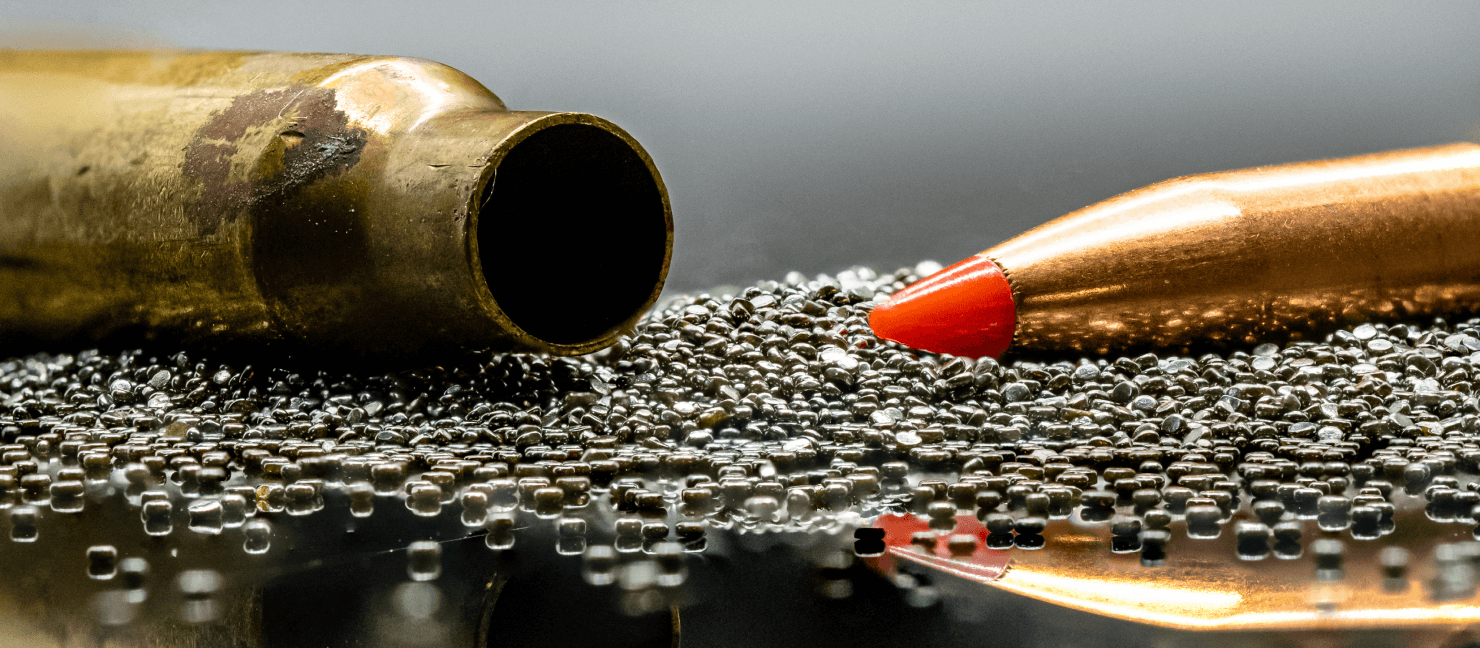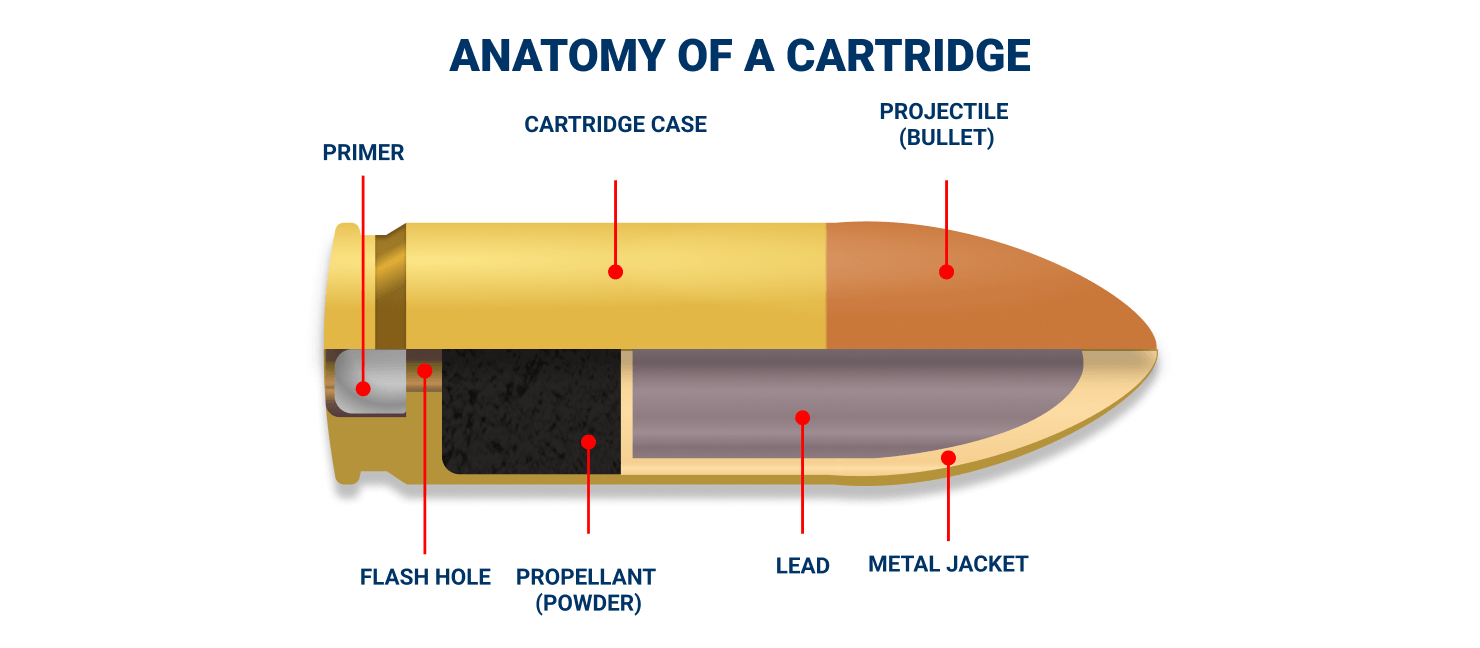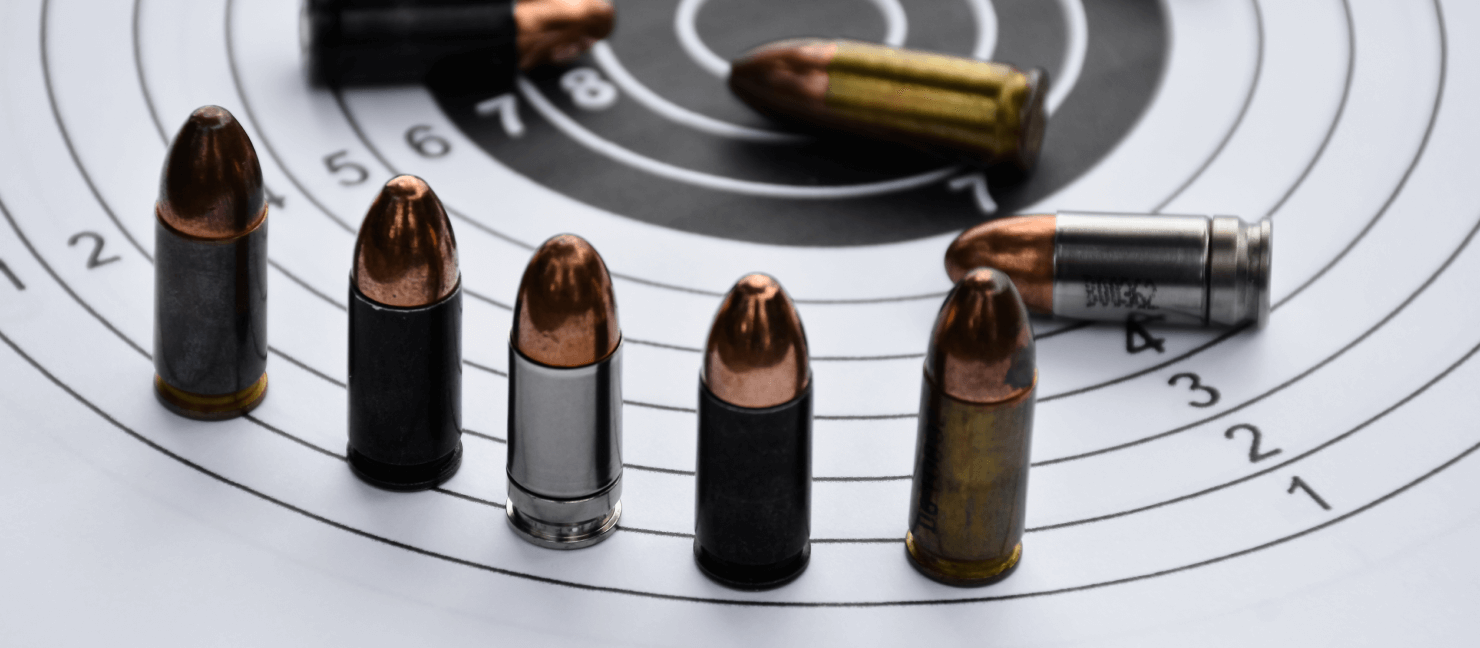What Is Bullet Grain? Discover How Grain Affects Performance

When you pick up a box of ammo, you may zero in on that mysterious ‘grain’ metric. But what exactly is bullet grain, and should shooters, hunters, and enthusiasts really pay much attention to it? In this guide, you’ll learn all about what bullet grain is, the types of bullet grains, and how to choose between them!
Key Takeaways
- What is Bullet Grain? Bullet grain is a measurement that refers to a bullet's weight or mass (the projectile — not the entire cartridge). This weight affects velocity, energy, trajectory, and more.
- Light vs Heavy Bullet Grain: Lighter bullets travel faster and have a flatter trajectory, while heavier bullets carry more energy. What’s considered light & heavy greatly depends on the caliber. For 9mm ammo, light grain is 115 grains or below while heavy grain is above 115 grains.
- Which Bullet Grain is Right for You? The best bullet grain varies based on which firearm you have and its use. For target practice, use the 55-115 grain range. Need the right grain for self-defense? Go with 115-147 grains. Planning your next deer hunt? Choose 150-180 grains.
What is Bullet Grain?
Simply put: Bullet grain refers to a bullet’s weight. This weight impacts accuracy, recoil, speed, and power. When you look at an ammo box, you’ll most commonly see two shortened abbreviations: ‘GR’ or ‘GRS’ — both represent bullet grain.

A single grain is just 1/7,000th of a pound (or about 1/437.5th of an ounce). To help you better realize just how small a bullet grain is, here are a few examples of everyday, common objects’ weight in grains:
- Penny = 38.6 grs
- Paper clip = 14.96 grs
- Postage stamp = 2.83 grs
But what parts of a round actually matter when it comes to grain count? In general, you’ll find four components that make up one bullet: the projectile, cartridge, powder, and primer. Bullet grain only refers to the weight of the projectile.

You can tell what a bullet’s grain is by reading the information written on the ammunition box by the manufacturer. While different grains have different benefits, it’s important to remember that every type of gun can only use a specific range of bullet grain.

Why Is Bullet Grain Important?
Bullet grain should be an important consideration for shooters who prioritize better performance (or accuracy) and terminal ballistics.
- Bullet grain greatly influences your firearm’s performance: helping a bullet to maintain its path and retain effectiveness in various conditions. Grain cannot save a poorly lined up shot. However, paired with practice and skill, bullet grain can help you achieve better overall accuracy.
- Grain also impacts terminal ballistics, which includes factors like trajectory, velocity, and energy upon impact. Heavier bullets typically maintain their strength well, allowing them to sink deeper into their targets. Lighter bullets, on the other hand, travel faster and stay on course better.
- The right bullet grain can help you feel more comfortable while shooting. Improved recoil and control help make for a better overall experience.
- When using a compensated firearm, use lighter grains to get the maximum benefit (more energy to shoot the projectile).
- Minimize the point of impact (POI) shift by using the same grain weight for practice (where you’ll most likely use ball or FMJ ammo) and self defense ammo (typically hollow point ammo).
Expert Tip:
Heavier bullets have more recoil since they have more momentum when fired — yielding greater discomfort and less control. Lighter bullets have less recoil: leading to less discomfort and more control. The amount and type of powder in the cartridge also contribute to this, too.
Bullet Grain + Accuracy
Bullet grain affects accuracy by influencing stability and matching the gun’s twist rate. Twist rate is how fast the barrel spins the bullet to keep it stable.
- Heavier bullets need a faster twist rate to stay steady and accurate.
- Lighter bullets can stay stable with a slower twist rate.
Matching the right bullet with the correct twist rate helps the bullet fly straight and true. Using the right bullet grain with the right twist rate is key for the best accuracy and performance in shooting.
| Achieving a Straight Line When Firing | |||
|---|---|---|---|
| Bullet Weight | Grain Example | Straight Line | Wobbly Line |
|
Light |
55 grs |
Slow twist rate |
Fast twist rate |
|
Heavy |
75 grs |
Fast twist rate |
Slow twist rate |
Bullet Grain + Environmental Considerations
Range and practice shooting offers both indoor and outdoor venues. However, outdoor uses like hunting and sport shooting include environmental factors like wind and distance. Temperature, humidity, and altitude can impact bullet performance when shooting outdoors:
- Higher temperatures and lower humidity decrease air density, allowing bullets to travel faster and with less drag.
- Similarly, shooting at higher altitudes can increase the range and flatness of a bullet's trajectory. Have a couple ammo boxes with different bullet grains on hand for different conditions.
- When using a rifle, match your grain to your firearm’s twist rate.
- More humidity increases drag. Aim your firearm a little higher when shooting in higher humidity.
- Keep a couple of different bullet grains in the calibers you use on hand, so you’re able to gauge the weather conditions and compensate accordingly.
Expert Tip:
You don't change the bullet as a result of wind conditions. You simply adjust your aim.
What Is Bullet Drag?
The shape of the bullet and how fast it's going can affect how much drag it feels. In shooting, minimizing drag is important because less drag means the bullet can travel farther and stay on target more accurately.

Imagine you're throwing a ball through the air. When you throw it, the air around the ball pushes against it, making it slow down a bit. This push from the air is what we call ‘drag’.
Now, think of a bullet flying through the air after you fire your gun. Just like the ball, the air around the bullet pushes against it as it moves forward. This air resistance (or bullet drag) slows down the bullet as it travels.
Light Bullet Grain vs Heavy Bullet Grain
Bullet grain varies by caliber. That means what’s considered light for a handgun’s 9mm wouldn’t apply to the rifle’s 5.56mm. Projectile weight (bullet grain) ranges from 15 grs for smaller calibers to 700 grs for larger ones.
Overall, caliber plays a crucial role in a projectile's weight. A bullet caliber indicates the internal diameter of a gun barrel and — in turn — the diameter of the bullets designed to fire from that firearm. Let’s explore the different ranges in popular bullet grains for the most popular calibers:
| Bullet Grain by Caliber Chart | ||||
|---|---|---|---|---|
| Caliber | Most Common Bullet Size | Bullet Size Range | Caliber Type | Usage |
|
.22LR |
40 grs |
30-40 grains |
Rimfire cartridge |
Small game hunting; Target shooting; Plinking |
|
.22 WMR |
40 grs |
30-50 grains |
Rimfire |
Varmint control; Small game hunting |
|
9mm |
115 grs |
115-147 grains |
Pistol |
Personal Defense; Law enforcement; Competitive shooting |
|
.380 ACP |
85-95 grs |
45-100 grains |
Pistol |
Personal Defense; Concealed carry |
|
.40 S&W |
165 & 180 grs |
105-200 grains |
Pistol |
Personal Defense; Law enforcement |
|
.45 ACP |
230 grs |
68-300 grains |
Pistol |
Personal Defense; Military use; Target shooting |
|
.38 Special |
158 grs |
110-158 grains |
Revolver |
Personal Defense; Target shooting; Backup gun |
|
.357 Magnum |
125 grs |
100-200 grains |
Handgun; Carbine |
Varmint (< 50 lbs); Medium Game (50-300) lbs; Hunting; Personal Defense |
|
.44 Magnum |
240 grs |
180-340 grains |
Handgun; Rifle |
Medium Game (50-300 lbs); Large Game (300-1500 lbs); Hunting |
|
.308 Caliber |
150-180 grs |
100-240 grains |
Rifle |
Large Game (300-1500 lbs); Dangerous Game; Sniping |
|
5.56mm |
55 & 62 grs |
40-80 grains |
Rifle |
Personal Defense; Varmint (< 50 lbs); Medium Game (50-300 lbs); Military use |
|
45-70 |
300-400 grs |
250-500 grains |
Rifle |
Hunting (good for hunting in the brush) |
|
30-06 |
150, 165, & 180 grs |
110-220 grains |
Rifle |
Large Game hunting; Military use; Long-range shooting |
|
.243 |
80 & 100 grs |
55-115 grains |
Rifle |
Varmint control; Deer hunting; Target shooting |
|
6.5 Creedmoor |
140-150 grs |
95-150 grains |
Rifle |
Long-range precision shooting; Medium game hunting |
Expert Tip:
9mm bullet grain usually ranges from 90 grains (light) to 147 grains (heavy) — with 115 being the average. AR-15 ammo typically uses 55-grain.
Explore light vs heavy grain by using the following links:
When to Use a Light Bullet Grain
Light bullet grain is most commonly used in situations where precision and control are essential, such as:
- Range Shooting & Practice
- Sport Shooting
- Varmint Hunting
Range Shooting and Practice
Range and practice shooting depend on a combination of your shooting skills plus the bullet’s natural accuracy and performance. Using lighter projectiles for practice makes for a more comfortable shooting experience. They also help novice shooters get to know their specific firearm’s handling and other characteristics.
Expert Tip:
For range shooting and practice, standard-weight bullets are the best option because they balance recoil, accuracy, and cost.
Sport Shooting
For sport shooting at long distances, choose lighter bullets. Lighter bullets move faster and stay on course better. Keep in mind, though, that wind affects them more. Always pick bullet weights based on the expected wind conditions to improve accuracy.
Rifle shooters should consider which type of rifle to use. Different rifles work better with certain bullet weights because of how fast the barrel twists.
- Lighter bullets often work better with rifles that have faster barrel twists.
- Shooters can match bullet weight with the rifle's twist rate by checking the manufacturer's recommendations.
Varmint Hunting
Varmint hunters can also use lighter bullets. These small, fast projectiles work well for hunting small animals and pests. They move quickly and stay accurate over short to medium distances. The lighter weight means less recoil, so hunters have better control and precision.

When to Use a Heavy Bullet Grain
Heavy bullet grain is most commonly used in less controlled environments and situations where strength and power are needed, such as:
- Hunting
- Self-defense
Hunting
Heavier bullets hit harder, which is great for hunting different, larger animals. Hunters who want quick and ethical kills may choose heavier bullets. However, heavier bullets move slower. Using heavier grains might mean that you need to change how you shoot. (getting closer to the target or aiming more carefully, for example).
Self-Defense
Self-defense usually happens at close distances. At close range, heavier bullets are better because they cause more damage — effectively stopping targets faster. Choosing heavier bullets helps protect others in public situations, since heavy grain projectiles tend to not penetrate all the way through the target.
Heavy grain bullets do cost more; however, practicing with them:
- Helps you prepare
- Load the bullets correctly
- Shoot accurately when it counts
Which Bullet Grain Is Right for You?
When should you choose light vs heavy bullet grain? Light grain bullets are perfect for range, sport, & practice shooting plus varmint hunting (small animals). Heavy grain bullets suit hunting large game as well as self-defense purposes.
Given how much the grain impacts the projectile’s path and accuracy, opting for the right weight can improve your shooting skills! Either way, you shouldn’t just choose the cheapest ammo box in the aisle. Take a look at this summary:
| When to Use Light & Heavy Bullet Grain | |||
|---|---|---|---|
| Use Case | Light Bullet Grain* | Heavy Bullet Grain* | Reason* |
|
Range Shooting and Practice |
Yes |
No |
Provides accuracy, consistent performance, and a comfortable shooting experience ideal for beginners. |
|
Sport Shooting |
Yes |
No |
Beneficial for long-range shooting due to faster bullet speed, though affected by wind; better with faster barrel twist rates. |
|
Varmint Hunting |
Yes |
No |
Works well for small game due to high velocity and precision, with less recoil for greater control and precision. |
|
Hunting |
No |
Yes |
Performs better for hunting larger animals by transferring more energy to the target, though requires closer range and precise shooting. |
|
Self-defense |
No |
Yes |
Causes more damage at close range, essential for stopping power in critical situations, though requires practice for reliability. |
|
* = Our general recommendations and/or reasons. Test using different grains to find what works best for you. |
|
|
|
Choosing the right bullet grain depends on what firearm you have, how you plan to use it, and your personal preferences.
- Step 1: Decide on your firearm's use — Determine if you will use your firearm for target practice, hunting, sport shooting, or self-defense.
- Step 2: Consider your shooting goal — Lighter grains for long-distance accuracy. Heavier grains for better stopping power in self-defense. Consider wind and distance for hunting and sport shooting.
- Step 3: Consider environmental factors — Evaluate how temperature, humidity, and altitude affect bullet performance: Higher temperatures and lower humidity make bullets faster. Shooting at higher altitudes can extend bullet range and straighten trajectory.
- Step 4: Match bullet grain to your firearm — Follow the manufacturer’s or a professional’s recommendations. Factor in your firearm’s barrel length for optimal bullet speed and stability.
- Step 5: Test different bullet grains — Experiment with shooting various grains to find what suits you best in terms of recoil, accuracy, and handling.
- Step 6: Check cost and availability — Compare the cost and availability of different bullet grains: Common bullet grains are cheaper and easier to find. Specialized bullet grains may be more expensive and harder to find.
- Step 7: Seek advice from experienced shooters — Get recommendations from experienced shooters in your area of interest: Join hunting communities, sport shooting forums, or self-defense groups for valuable insights.
Have Fun Out There!
Ready to find the perfect ammunition for your shooting needs? With a wide selection of top-quality ammunition for all activities. From target practice to hunting and self-defense, Academy Sports + Outdoors has you covered! Shop online or visit your nearest store today to discover the right bullet grain for your firearm.


